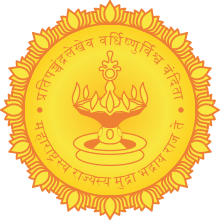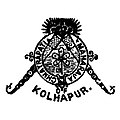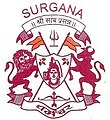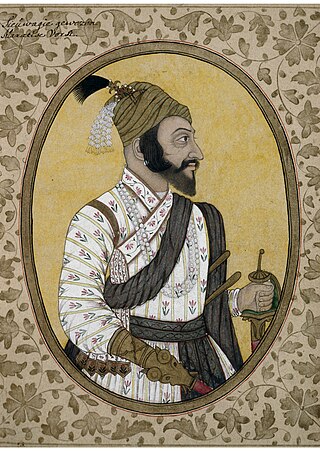
Shivaji I was an Indian ruler and a member of the Bhonsle Maratha clan. Shivaji carved out his own independent kingdom from the declining Adilshahi Sultanate of Bijapur that formed the genesis of the Maratha Empire. In 1674, he was formally crowned the Chhatrapati of his realm at Raigad Fort.

The State Emblem of India is the national emblem of the Republic of India and is used by the union government, many state governments, and other government agencies. The emblem is an adaptation of the Lion Capital of Ashoka, an ancient sculpture dating back to 280 BCE during the Maurya Empire. The statue is a three dimensional emblem showing four lions. It became the emblem of the Dominion of India in December 1947, and later the emblem of the Republic of India. The State Emblem of India is an official seal of the Government of India. It is used as the national emblem of India and appears on official documents, currency and passports.

Kolhapur is a city on the banks of the Panchganga River in the southern part of the Indian state of Maharashtra.
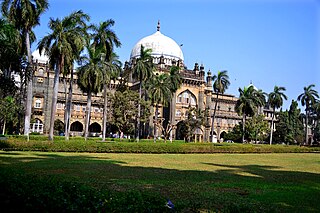
Chhatrapati Shivaji Maharaj Vastu Sangrahalaya, (CSMVS) originally named Prince of Wales Museum of Western India, is a museum in Mumbai (Bombay) which documents the history of India from prehistoric to modern times.
Desh is a region adjacent to the Western Ghats between the Godavari River and Krishna River, a part of Deccan Plateau, in the states of Maharashtra, Karnataka, and Andhra Pradesh. The region is hilly and slopes towards the east, and is drained by the upper reaches of the Godavari and Krishna rivers and their tributaries.

Shahu of the Bhonsle dynasty of Marathas was a Raja and the first Maharaja (1900–1922) of the Indian princely state of Kolhapur. Rajarshi Shahu was considered a true democrat and social reformer. Shahu Maharaj was an able ruler who was associated with many progressive policies during his rule. From his coronation in 1894 till his demise in 1922, he worked for the cause of the lower caste subjects in his state. Primary education to all regardless of caste and creed was one of his most significant priorities.
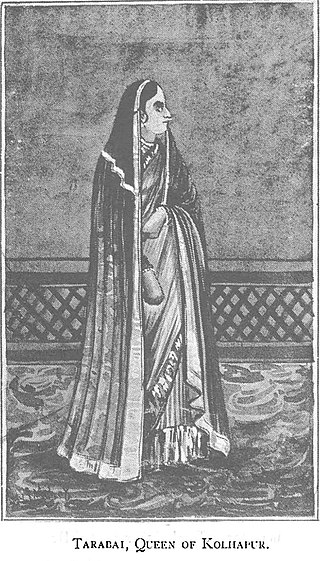
Tarabai Bhosale (née Mohite) was the regent of the Maratha Empire from 1700 until 1708. She was the queen of Rajaram I, and daughter-in-law of the empire's founder Shivaji I. She is acclaimed for her role in keeping alive the resistance against Mughal occupation of Maratha territories after the death of her husband, and acting as the regent during the minority of her son, Shivaji II.
Kagal is a town in Kolhapur district of the Indian state of Maharashtra.
Chauth was a regular tax or tribute imposed from the early 18th century by the Maratha Empire in the Indian subcontinent. It was an annual tax nominally levied at 25% on revenue or produce, hence the name, on lands that were under nominal Mughal rule. The sardeshmukhi was an additional 10% levy on top of the chauth. A tribute paid to the king, it was started by Koli Maharaja Som Shah of Ramnagar.

Shri Shahu Chhatrapati Maharaj of Kolhapur is the descendent of Chhatrapati Shivaji Maharaj and the great-grandson of Rajarshi Chhatrapati Shahu Maharaj of Kolhapur and the son and heir of Maj. Gen. Shahaji Chhatrapati Maharaj of Kolhapur. He studied at the Bishop Cotton School, Bangalore and later on graduated from the Indore Christian College in 1967 with History, Economics and English literature.

Balwant Moreshwar Purandare, popularly known as Babasaheb Purandare, was an Indian writer of books and plays from Maharashtra, India. His works are mostly based on the life of Chatrapati Shivaji Maharaj, the 17th-century founder of the Maratha Empire; as a result he is called Shiv-Shahir. He is mostly known for his popular play on Shivaji, Jaanta Raja. Purandare also studied the history of the Peshwas of Pune. In 2015, he was awarded the Maharashtra Bhushan Award, Maharashtra's highest civilian award. He was awarded the Padma Vibhushan, India's highest second-civilian award on 25 January 2019.

Vishalgad was a jagir during the Maratha Empire and then later part of the Deccan States Agency of the British Raj. It was governed by Deshastha Brahmins, who were feudatories of Kolhapur State.
Bhoite is a surname found amongst the Maratha caste, mainly in the state of Maharashtra in India but it also appears in Indian states bordering Maharashtra.

Panhala fort, is located in Panhala, 20 kilometres northwest of Kolhapur in Maharashtra, India. It is strategically located looking over a pass in the Sahyadri mountain range which was a major trade route from Bijapur in the interior of Maharashtra to the coastal areas. Due to its strategic location, it was the centre of several skirmishes in the Deccan involving the Marathas, the Mughals and the British the grand son's of chhatrapati shivaji maharaj East India Company, the most notable being the Battle of Pavan Khind. Here, the queen regent of Kolhapur, Tarabai Ranisaheb, spent her formative years. Several parts of the fort and the structures within are still intact. It is also called as the 'Fort of Snakes' as it is zigzagged in shape.

New Palace, Kolhapur is a palace situated in Kolhapur, in the Indian state of Maharashtra. The Palace took 7 years to complete, from 1877 to 1884, costing about seven lakhs of rupees. Being an excellent specimen of Indian architecture built in black polished stone, it has been an attraction for tourists. It has extensive premises with a garden, fountain and wrestling ground. The whole building is eight-angled and has a tower in the middle. The clock on it was fixed in 1877. At separate distances there are small towers. On every glass are painted the events of Chhatrapati Shivaji Maharaj's life, the founder of Maratha Empire. There is a zoo and a ground lake. Even today, it is the residence of Chhatrapati Shahu Maharaja, the direct descendant of Chhatrapati Shivaji Maharaja.

Kolhapur State or Kolhapur Kingdom (1710–1949) was a Maratha princely State of India, under the Deccan Division of the Bombay Presidency, and later the Deccan States Agency. It was considered the most important of the Maratha principalities with the others being Baroda State, Gwalior State and Indore State. Its rulers, of the Bhonsle dynasty, were entitled to a 19-gun salute – thus Kolhapur was also known as a 19-gun state. The state flag was a swallow-tailed saffron pennant.
Madhavrao Khanderao Bagal, also called Bhai Madhavrao Bagal, was a noted writer, artist, journalist, social reformer, political activist, orator and freedom fighter from Kolhapur.
Annaji Datto Sachiv was the Sachiv in the Ashta Pradhan mandal of the Maratha Empire during the rule of Shivaji.
Gopal Balwant Kamble was an Indian painter known for painting Bollywood movie posters and realist portraits of people from Maharashtra.
